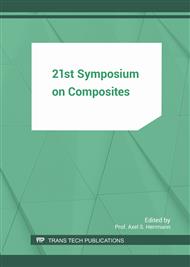[1]
Bundesministerium für Ernährung und Landwirtschaft (BMEL): Nationale Politikstrategie Bioökonomie - Nachwachsende Ressourcen und biotechnologische Verfahren als Basis für Ernährung, Industrie und Energie, Berlin, 2014, pp.1-80.
DOI: 10.1515/9783110655308-003
Google Scholar
[2]
IfBB - Institute for Bioplastics and Biocomposites: Biopolymers - facts and statistics, Hanover, 2015, pp.1-47.
Google Scholar
[3]
H. -J. Enders, A. Siebert-Raths: Technische Biopolymere: Rahmenbedingungen, Marktsituation, Herstellung, Aufbau und Eigenschaften, München, Carl Hanser Verlag, (2009).
DOI: 10.3139/9783446421042.fm
Google Scholar
[4]
M. Neitzel, P. Mitschang,U. Breuer: Handbuch Verbundwerkstoffe - Werkstoffe, Verarbeitung, Anwendung, München, Carl Hanser Verlag, (2014).
DOI: 10.3139/9783446436978.fm
Google Scholar
[5]
Á. Kmetty, T. Bárány, J. Karger-Kocsis: Self-reionforced polymeric materials: A review, in: Proress in Polymer Science, 2010, pp.1288-1310.
DOI: 10.1016/j.progpolymsci.2010.07.002
Google Scholar
[6]
N. Capiati, R. Porter: The concept of one polymer composites modelled with high density polyethylene, in: Journal of Materials Science, 10, 1975, pp.1671-1677.
DOI: 10.1007/bf00554928
Google Scholar
[7]
J. Karger-Kocsis, S. Siengchin: Single-Polymer Composites - Concepts, Realization and Outlook: Review, in: KMUTNB International Journal of Applied Science and Technology, 7, 2014, pp.1-9.
DOI: 10.14416/j.ijast.2014.01.002
Google Scholar
[8]
W. Jia: Polylactic Acid Fibre Reinforced Biodegradable Composites, PhD Thesis, The University of Manchester, Manchester, (2015).
Google Scholar
[9]
T. Köhler, K. Vonberg, G. Seide, T. Gries: Self-reinforced composites made from PLA hybrid yarns, in: Simončič, Tomšič et al. (Hg. ) 8-10 June 2016 – 16th World Textile Conference AUTEX, 2016, pp.1-7.
Google Scholar
[10]
C. Cherif: Textile Werkstoffe für den Leichtbau, Techniken – Verfahren – Materialien – Eigenschaften, Berlin Heidelberg, Springer-Verlag, (2011).
DOI: 10.1007/978-3-642-17992-1
Google Scholar
[11]
COMFIL ApS, Gjern, Denmark: http: /www. comfil. biz/srp, accessed 02. 03. (2017).
Google Scholar
[12]
Project BIO4SELF: http: /www. bio4self. eu, accessed 02. 03. (2017).
Google Scholar
[13]
S, Ramaswamy, M. -I. Popzyk, T. Gries: Development of biobased self-reinforced polymer composites - BioSRPC, in: Abschlussbericht zum Forschungsvorhaben IGF 90 EN am Institut für Textiltechnik der RWTH Aachen University, Aachen 2015, pp.1-112.
Google Scholar


